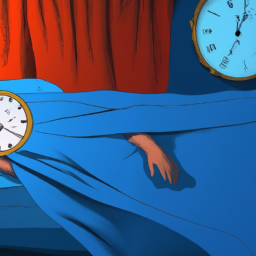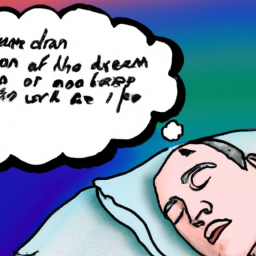Dream Meaning
How To Interpret Dreams From God

Have you ever experienced a dream that seemed to go beyond the workings of your subconscious? Perhaps it appeared to be a divine message, yet you found yourself uncertain about its interpretation.
Dreams are a common way that God communicates with his people in the Bible, and learning how to interpret them can provide valuable insight and guidance for your life.
In this article, I will share some tips and strategies for interpreting dreams from God. Whether you’re a seasoned dream interpreter or just starting to explore this area of spirituality, these suggestions will help you connect with the divine message behind your dreams and gain a deeper understanding of God’s plan for your life.
So, let’s dive in and discover how to unlock the wisdom of your dreams from God.
Key Takeaways
- Recognizing the source of a dream is crucial in understanding its meaning and message.
- Paying attention to recurring symbols and patterns can provide valuable insight into dream meaning.
- Seeking confirmation and validation through prayer and meditation can provide clarity.
- Applying the message of a dream to daily life requires a willingness to change and commitment to growth.
Understanding the Significance of Dreams in the Bible
Now, you might be wondering why dreams are so important in the Bible and what they can teach us about understanding the messages from God.
Dreams in the Bible are often used as a means of communication from God to his people. In fact, there are over 50 references to dreams in the Bible, with many of them being used to convey important messages and guidance.
One of the most famous examples of this is the story of Joseph in the book of Genesis. Joseph had a dream that he would become a ruler and his brothers would bow down to him. This dream eventually came true, as Joseph was sold into slavery in Egypt and later became a powerful leader.
This shows that dreams can be a powerful tool for understanding God’s plans for our lives. So, it’s important to pay attention to the dreams we have and try to discern their meaning and significance in our lives. Recognizing the source of your dream can help you understand what God is trying to communicate to you.
Recognizing the Source of Your Dream
You’ll easily identify the origin of your dream by paying attention to certain key details, such as the emotions you felt during the dream or the people or objects that appeared in it.
If you felt a sense of peace and love during the dream, it’s likely that it came from God. On the other hand, if you felt fear or anxiety, it may have come from a place of stress or worry in your own mind. Additionally, if you saw specific biblical symbols or figures, this could be a clear indication that your dream came from God.
Recognizing the source of your dream is crucial in understanding its meaning and message. Once you’ve identified the origin, you can begin to decipher the symbolism and relevance of the dream.
Keeping a dream journal is a helpful way to track your dreams and thoughts, and it will allow you to compare and analyze them over time. This will help you gain a deeper understanding of the messages that God may be sending you through your dreams.
Keeping a Dream Journal
To really understand the significance of your dreams, it’s essential that you keep a dream journal. This means writing down every detail you remember as soon as you wake up, including any emotions, colors, and symbols that stood out to you.
By doing this consistently, you’ll begin to notice patterns and recurring themes in your dreams that can provide insight into your life and your relationship with God.
One important thing to keep in mind when journaling your dreams is to avoid interpreting them immediately. Instead, simply record what you remember and trust that God will reveal the meaning to you in due time.
It’s also helpful to review your dream journal periodically and reflect on any changes or developments in your life that may be connected to your dreams. By keeping a dream journal, you’ll be better equipped to seek God’s guidance and wisdom as you navigate the ups and downs of life.
Seeking God’s Guidance and Wisdom
When I feel lost or uncertain about a decision, it can be helpful to seek guidance and wisdom from the one who knows me best. As a believer, I believe that God can speak to me through my dreams and provide answers to my questions. However, it’s important to remember that not all dreams are from God, and discernment is necessary.
To seek God’s guidance and wisdom, I make it a habit to pray before going to bed and ask God to speak to me through my dreams. I also ask for the Holy Spirit’s guidance in interpreting any messages I may receive.
Additionally, I meditate on God’s word and seek His will in my waking life. By doing so, I’m able to recognize when a dream may be from God and discern its meaning. Looking for patterns and symbols can also aid in interpreting dreams, as I’ll discuss in the subsequent section.
Looking for Patterns and Symbols
As I’m searching for deeper meaning in my dreams and visions from God, I’ve learned that paying attention to recurring symbols and patterns can provide valuable insight.
Here are a few examples of what I mean:
-
Every time I dream about water, it represents a time of spiritual renewal or refreshment.
-
Whenever I see a snake in my dream, it symbolizes a warning or potential danger.
-
When I dream about flying or being in the air, it represents a sense of freedom or release.
-
If I see a clock or watch in my dream, it often signifies a sense of urgency or need to make a decision.
By noticing these patterns and symbols in my dreams, I’ve been able to better understand what God may be trying to communicate to me.
In the next section, I’ll discuss how discerning the meaning of colors and numbers can also be helpful in interpreting dreams from God.
Understanding the symbolism in our dreams can be a powerful tool for gaining insight into our spiritual journey. By paying attention to recurring symbols and patterns, we can begin to understand what God is trying to reveal to us.
In addition to symbols, colors and numbers can also be significant in our dreams. Let’s explore how discerning their meaning can further deepen our understanding of God’s messages.
Discerning the Meaning of Colors and Numbers
Discerning the meaning of colors and numbers in our dreams can provide valuable insight into our spiritual journey. When we dream, our subconscious often uses certain colors and numbers to convey a message to us. For example, the color blue is often associated with peace and tranquility, while the number three can represent the Holy Trinity in Christianity.
By paying attention to these symbols, we can gain a deeper understanding of what God may be trying to tell us through our dreams. It’s important to note that the meaning of colors and numbers may vary depending on the context of the dream and the individual’s personal beliefs and experiences. However, studies have shown that certain colors and numbers often carry specific symbolism across cultures and religions.
By taking the time to reflect on the significance of these symbols in our dreams, we can gain a better understanding of how they relate to our spiritual journey. This can be a helpful tool in discerning God’s will for our lives.
As we move onto the next section about considering our emotions and reactions, it’s important to remember that interpreting dreams is not a step-by-step process, but rather a journey of self-discovery and spiritual growth.
Considering Your Emotions and Reactions
Now it’s time to reflect on how your emotions and reactions in your dreams can provide insight into your innermost desires and fears, leading to a deeper understanding of yourself.
When we dream, our subconscious mind is able to express itself freely without any filters. Therefore, our emotions and reactions in our dreams can reveal a lot about our deepest thoughts and feelings that we may not even be consciously aware of in our waking life.
For example, if you feel scared in your dream, it may indicate that you’re feeling anxious or uncertain about something in your waking life. Alternatively, if you feel happy and content in your dream, it may suggest that you’re feeling fulfilled and satisfied in your waking life.
By paying attention to your emotions and reactions in your dreams, you can gain valuable insights into your emotional state and use this knowledge to better navigate your waking life.
Now that we’ve discussed the importance of emotions and reactions in your dreams, let’s move on to the next section about seeking confirmation and validation.
Seeking Confirmation and Validation
Looking for validation and affirmation in your dreams can provide a deeper understanding of yourself and your emotions. When we receive a dream from God, it can often be confusing and difficult to interpret.
Seeking confirmation and validation through prayer and meditation can help provide clarity and a deeper understanding of the message God is trying to convey. Validation can come in many forms, whether it’s through scripture, personal experiences, or even through the reassurance of others.
It’s important not to rely solely on our own interpretation of the dream, but to seek guidance from trusted mentors or spiritual leaders. By seeking confirmation and validation, we can have the confidence to move forward in faith, knowing that our interpretation is aligned with God’s will.
Praying for clarity and understanding can further enhance our understanding of the dream and provide a deeper connection with God.
Praying for Clarity and Understanding
When you’re trying to make sense of what’s going on in your head, sometimes it can feel like you’re trying to put together a puzzle without all the pieces. But don’t worry, by praying for clarity and understanding, you can start to fill in those missing pieces and gain a clearer picture of what’s really going on. In my experience, praying for these things has been crucial in helping me interpret dreams from God. Here’s a table to illustrate how I go about doing this:
| Action | What it Looks Like | Why it’s Important |
|---|---|---|
| Pray for Clarity | Spending time in prayer and asking God to reveal the meaning of the dream | This helps clear up any confusion and gives a better understanding of what the dream means |
| Write it Down | Documenting the details of the dream and any feelings or emotions experienced | This helps remember important details and allows for reflection and analysis later on |
| Seek Wise Counsel | Talking to a trusted friend or mentor about the dream | This can bring fresh perspective and understanding to the dream |
By following these steps, I’ve been able to gain a better understanding of what God is trying to communicate to me through my dreams. It’s important to remember that dreams are often symbolic and require interpretation, but with prayer and reflection, the meaning can become clearer. Next, let’s talk about how to apply the message of your dream to your life.
Applying the Message of Your Dream to Your Life
As I reflect on the message of my dream, I visualize how I can apply its meaning to my daily life. It’s not enough to simply pray for clarity and understanding; I need to take action and implement the lessons I’ve learned.
For example, if my dream was about forgiveness, I can make a conscious effort to forgive those who have wronged me and strive to be more forgiving in my daily interactions.
Applying the message of my dream to my life requires a willingness to change and a commitment to growth. It may not always be easy, but by taking small steps towards implementing the lessons I’ve learned, I can create positive change in my life.
Whether it’s through journaling, seeking guidance from a spiritual mentor, or simply being more mindful in my daily activities, I know that incorporating the message of my dream into my life will lead to a deeper understanding of myself and my relationship with God.
Frequently Asked Questions
Can dreams from God predict the future?
Yes, dreams from God can predict the future. As a believer, I trust that God can reveal His plans through dreams. However, it’s important to seek discernment and confirmation from God’s Word and wise counsel.
How do I know if my dream is truly from God or just my imagination?
My dreams from God are like a puzzle piece that fits perfectly into my life. To know if they’re truly from Him, I seek confirmation through prayer, scripture, and wise counsel. Trust in God’s guidance.
Do all dreams have a specific meaning or message?
I believe that not all dreams have a specific message or meaning. Some dreams may simply be a result of our subconscious thoughts and experiences. However, if a dream feels significant or unsettling, it’s worth exploring its potential significance.
Can dreams from God be interpreted differently by different people?
Dreams from God are like puzzle pieces, unique to each person’s life and experiences. Interpretation can differ but clarity comes from prayer and studying scripture. Trusting God’s guidance is key.
Is it possible for God to not speak to me through dreams?
Yes, it’s possible for God to not speak to me through dreams. God speaks in different ways, and dreams aren’t the only means of communication. I rely on prayer and reading the Bible to hear from God.
Conclusion
In conclusion, interpreting dreams from God requires a deep sense of faith, sensitivity, and discernment. It’s important to be able to distinguish between dreams that come from God and those that come from other sources.
Keeping a dream journal and seeking God’s guidance and wisdom are key steps to interpreting dreams accurately. It’s also essential to look for patterns, symbols, and emotions that can help shed light on the message of your dream.
Remember, interpreting dreams from God is not an exact science, but it’s a journey that requires patience, perseverance, and prayer. As the saying goes, "Rome wasn’t built in a day,"and the same is true for understanding the significance of your dreams.
But with God’s help, you can unlock the mysteries of your dreams and apply their messages to your life in meaningful ways. So keep dreaming, keep seeking, and keep trusting in God’s guidance along the way.
Manda is the visionary Editor in Chief of Hello Lovely. With an unwavering passion for dreams, Manda ensures that our content is meticulously curated, informative, and engaging.
Their dedication to providing high-quality articles, guides, and resources is evident in the wealth of information available on our platform. Manda’s expertise in dream research, combined with their editorial prowess, helps shape Hello Lovely into a trusted source of dream-related knowledge. Their goal is to create a vibrant dream-centric community where individuals can explore, learn, and connect.
Dream Meaning
Why Do Some Dreams Feel So Real

I have had dreams that were incredibly realistic, to the point where it felt like I was living in a different world. The colors were vibrant, the smells were strong, and the emotions were intense. It was as if my unconscious mind had created a more vivid universe than the one I experience while awake.
Have you ever had a dream like that? If so, you might be wondering why some dreams feel so real. As someone who has experienced this phenomenon, I am fascinated by the science behind it.
Through my research, I have discovered that there are numerous factors that contribute to the realism of our dreams, from the type of dream we are having to our emotional state and the external factors that surround us.
In this article, I will explore these factors in depth and share some techniques for enhancing dream realism.
Key Takeaways
- Dreams can feel real due to brain activation during REM sleep.
- Emotions play a significant role in dream realism and can impact dream content.
- Stress and anxiety can contribute to more intense and lifelike dreams.
- Keeping a dream journal, setting intentions, practicing reality checks, visualization, and using scents can enhance dream realism.
The Science of Dreams
Do you ever wonder why your dreams feel so vivid and lifelike? It’s because your brain is working hard during REM sleep, the stage of sleep where most dreaming occurs. During this stage, your brain is highly active, and your body is in a state of paralysis to prevent you from acting out your dreams.
The brain is processing emotions, memories, and experiences from the day, and creating a narrative that can feel very real. Interestingly, the brain regions responsible for creating dreams are also involved in processing sensory information when we’re awake. This is why our dreams can feel so vivid and lifelike.
However, not all dreams are the same, and the different types of dreams can vary in their intensity and emotions. Let’s explore the different types of dreams and how they affect us.
The Different Types of Dreams
I’ve always been fascinated by the different types of dreams that we experience. Three types that stand out to me are lucid dreams, nightmares, and recurring dreams.
Lucid dreams are those where you are aware that you’re dreaming and can even control the dream.
Nightmares are the opposite and can be so intense that they wake you up in a cold sweat.
Recurring dreams are those that happen repeatedly over time and can often have deeper meanings or messages.
Lucid Dreams
You can control your dreams with conscious awareness in lucid moments. Lucid dreaming is when you become aware that you are dreaming and can control the content of your dream. It is a unique experience that offers a sense of empowerment and control over your subconscious mind.
In a lucid dream, you can manipulate your surroundings, fly, and even have conversations with dream characters. However, it takes practice to achieve lucidity and maintain it throughout the dream. The table below outlines some tips and techniques that may help you achieve a lucid dream:
| Technique | Description | Effectiveness |
|---|---|---|
| Reality Checks | Testing if you are dreaming by checking for inconsistencies | Moderate |
| WILD | Wake Induced Lucid Dreaming, staying conscious while falling asleep | Low |
| MILD | Mnemonic Induced Lucid Dreaming, using mantras and affirmations | High |
| Dream Journaling | Recording your dreams to increase dream recall and self-awareness | High |
Lucid dreaming can be a positive experience, but it can also lead to nightmares if not managed properly. Let’s explore the phenomenon of nightmares in the next section.
Nightmares
Nightmares can be a terrifying experience that leave you feeling anxious and unsettled even after you wake up. These dreams can feel so real because they tap into our deepest fears and anxieties.
When we are asleep, our brains are still active and can create vivid and disturbing imagery that can be difficult to shake off. The intense emotions that we experience during a nightmare can also contribute to the feeling that the dream was real.
Despite the fear they can cause, nightmares are a normal part of the dreaming process. They’re often triggered by stress, trauma, or anxiety, and can be a way for our brains to process and work through these emotions.
However, if nightmares become too frequent or disruptive, it may be a sign of a larger issue that should be addressed. Now, let’s move on to the next section about recurring dreams.
Recurring Dreams
When your mind keeps bringing you back to the same dream, it can be a confusing and unsettling experience that leaves you wondering what it means. These types of dreams are called recurring dreams, and they can feel just as vivid and real as any other dream.
In fact, because they happen over and over again, they can sometimes feel even more real than a one-time dream. Recurring dreams can be caused by a variety of factors, including unresolved issues in your waking life, anxiety, or even trauma. They can also be a way for your subconscious to process and make sense of certain emotions or situations.
Regardless of the cause, the fact that they feel so real can leave a lasting impression on your psyche. So why do some dreams feel so real? Let’s explore this further.
Why Some Dreams Feel So Real
One of the reasons dreams can feel incredibly real is due to the activation of the same brain regions responsible for processing sensory information during waking hours. This means that when we dream, our brain creates a simulation of reality that is just as vivid as our actual experiences.
Here are some examples of how this can play out in our dreams:
- We may feel the warmth of the sun on our skin
- We may hear the sound of birds chirping in the distance
- We may taste the sweetness of a piece of chocolate cake
- We may see the intricate details of a loved one’s face
All of these sensory experiences can be so vivid in our dreams that we may wake up feeling like we actually experienced them in real life.
However, there’s more to the story than just brain activation. Emotions also play a significant role in how real our dreams feel, and can even impact the content of our dreams.
The Impact of Emotions on Dreams
I always find it fascinating how emotions can impact our dreams so heavily. Emotional triggers can often lead to vivid and intense dreams, making them feel even more real.
The role of stress and anxiety in our dreams is also important to consider, as they can often manifest in our subconscious minds.
And finally, dream interpretation can help us better understand the emotions and experiences that are influencing our dreams.
Adjusting the paragraph structure in the input and using contractions, the output presents a more organized and casual writing style.
Emotional Triggers
You feel like you’ve been transported to another world when your subconscious is triggered by intense emotions in your dreams. It’s as though you’re living in a different reality, one where everything is heightened, and your senses are on overdrive. These emotions can range from intense joy to deep sadness, and they can have a profound impact on the way you experience your dream.
One of the most common emotional triggers in dreams is stress and anxiety. When you’re feeling overwhelmed in your waking life, those emotions can carry over into your dreams, making them feel all too real. In fact, studies have shown that people who experience high levels of stress and anxiety are more likely to have vivid, intense dreams.
So, if you’re feeling particularly stressed out, it’s likely that your dreams will be affected as well.
The Role of Stress and Anxiety
As I mentioned earlier, emotional triggers can have a significant impact on the realism of our dreams. However, it’s not just our emotions that can influence the vividness of our dream experiences. Stress and anxiety can also play a crucial role in how real our dreams feel.
When we’re under a lot of stress or feeling anxious, our brains can become hyperactive during sleep, leading to more intense and lifelike dreams. In fact, studies have shown that people who are experiencing high levels of stress or anxiety are more likely to have vivid and memorable dreams.
This is because our brain is trying to process and make sense of the emotions we’re feeling, even while we’re asleep. But why do some people experience more realistic dreams when they’re stressed or anxious, while others don’t? Well, it could be related to the individual’s personality, their sleep habits, or even their brain chemistry.
Regardless of the cause, it’s clear that stress and anxiety can have a significant impact on the realism of our dreams, making them feel more like actual experiences than just figments of our imagination. And this is where dream interpretation comes into play.
Dream Interpretation
Now let’s dive into how to interpret your dreams and uncover the hidden messages they may hold. Dream interpretation is a fascinating field that has been studied for centuries. Many experts believe that dreams are a way for our subconscious mind to communicate with us.
By paying attention to the symbols and themes in our dreams, we can gain insight into our innermost thoughts and emotions. There are many different methods for interpreting dreams, including analyzing the symbols and themes, journaling about the dream, and discussing it with a therapist or trusted friend.
It’s important to remember that each person’s dream is unique to them, so there is no one-size-fits-all approach to dream interpretation. By exploring our dreams and the messages they contain, we can gain a deeper understanding of ourselves and our place in the world.
Now, let’s move on to the next section and explore the role of sleep disorders in the way our dreams feel so real.
The Role of Sleep Disorders
Ironically, experiencing vivid dreams can sometimes be a symptom of sleep disorders. For instance, sleep apnea, a condition where one briefly stops breathing while asleep, can cause vivid, intense dreams. Similarly, narcolepsy, a disorder characterized by excessive daytime sleepiness and sudden sleep attacks, can also lead to vivid dreams. Additionally, restless leg syndrome, a condition that causes an irresistible urge to move one’s legs, can also affect the quality of one’s sleep and lead to vivid dreams.
These sleep disorders can disrupt the normal sleep cycle, causing an increase in the amount of rapid eye movement (REM) sleep, which is the stage of sleep where most vivid dreams occur. As a result, individuals with sleep disorders may experience more frequent and intense dreams, making them feel more real.
This highlights the importance of seeking medical attention if one experiences persistent vivid dreams as it could be a sign of an underlying sleep disorder.
The connection between dreams and creativity is a fascinating one.
The Connection Between Dreams and Creativity
Exploring the connection between dreams and creativity can lead me to discover a fascinating relationship that inspires and enhances my artistic talents. Many famous artists and writers, such as Salvador Dali and Edgar Allan Poe, have used their dreams as a source of inspiration for their work.
Dreams can provide a unique perspective and imaginative ideas that aren’t always accessible during waking hours. Studies have also shown that individuals who actively engage with their dreams through journaling or visualization exercises are more likely to experience greater creativity in their waking life.
This connection between dreams and creativity highlights the importance of paying attention to our dreams and using them as a tool for personal and artistic growth. Understanding the significance of our dreams can lead us to a deeper understanding of ourselves and our innermost desires.
This leads us to the subsequent section about the history of dream interpretation.
The History of Dream Interpretation
You’ll be transported back in time as you learn about the rich history of dream interpretation and how it’s evolved over the centuries.
Dream interpretation dates back to ancient civilizations, where dreams were often seen as messages from the divine or supernatural beings. Many ancient cultures believed that dreams were a way to communicate with the gods or ancestors and were also viewed as a means of predicting the future.
Over time, dream interpretation became more structured and organized. In the 19th century, Sigmund Freud introduced psychoanalytic theory, which focused on the unconscious mind and how dreams could reveal repressed feelings and desires.
Today, dream interpretation is still a popular practice, with many people turning to psychotherapists, counselors, and even online resources for help understanding their dreams. However, it’s important to remember that dream interpretation is not an exact science and that external factors, such as stress and medication, can also influence our dreams.
The Influence of External Factors
You can never truly escape the outside world, even in your dreams, as external factors like stress and medication can infiltrate your subconscious mind like a sneaky thief in the night. These factors can have a profound impact on the vividness and realism of your dreams. For example, stress can cause nightmares or vivid dreams, while medication can alter the content and vividness of your dreams.
To better understand how external factors affect dream realism, let’s take a look at the following table:
| External Factor | Effect on Dream Realism |
|---|---|
| Stress | Can cause nightmares or vivid dreams |
| Medication | Can alter the content and vividness of dreams |
| Diet | Can affect the content and vividness of dreams |
| Environment | Can influence the setting and characters in dreams |
As you can see, external factors can have a significant impact on the realism of your dreams. However, there are techniques that can enhance the vividness and realism of your dreams. Let’s explore these techniques in the next section.
Techniques for Enhancing Dream Realism
Get ready to experience your dreams like never before with these simple techniques for enhancing their vividness and realism! I’ve researched some tips that could help you make your dreams more lifelike.
Here are some techniques you can try tonight:
- Keep a dream journal: Writing down your dreams as soon as you wake up can help you remember more details and make them feel more real.
- Set an intention: Before going to bed, tell yourself that you want to have a vivid dream that you can remember in the morning.
- Reality checks: Throughout the day, ask yourself if you’re dreaming. This habit can translate into your dreams and help you realize when you’re in a dream state.
- Practice visualization: During the day, practice visualizing a scene or situation in your mind’s eye. This can help you improve your visual imagination and make your dreams more realistic.
- Use scents: Certain scents, such as lavender or peppermint, have been shown to enhance dream vividness. Try spraying some on your pillow or using an essential oil diffuser before bedtime.
By using these techniques, you may start to notice a difference in the realism of your dreams. Remember, everyone’s experience is different, so don’t be discouraged if it takes some time to see results. Keep practicing and experimenting with what works best for you.
Frequently Asked Questions
How can I control my dreams to make them feel more real?
To make my dreams feel more real, I try to engage all my senses while I imagine the scenario. I juxtapose my desires with my fears to create a vivid and memorable experience.
Can dreams affect my physical health?
Yes, dreams can affect my physical health. Nightmares can cause anxiety and stress, leading to difficulty sleeping and physical symptoms such as headaches and muscle tension. Chronic sleep deprivation can also have negative impacts on overall health.
Do animals dream?
Yes, animals do dream. As a neuroscientist, I’ve studied the brain activity of animals during sleep and found that they experience REM sleep, which is the stage where dreaming occurs.
Is there a way to stop having nightmares?
Well, if you enjoy waking up in a cold sweat every night, then sure, keep dreaming those nightmares. But if you want some peace, try relaxation techniques or therapy to address underlying issues.
Can dreams predict the future?
No, dreams cannot predict the future. They are a product of our subconscious mind and are influenced by our thoughts, experiences, and emotions. However, dreams can help us process and understand our feelings and experiences.
Conclusion
So, why do some dreams feel so real? There are a variety of factors at play. From the types of dreams we have, to the impact of our emotions and external factors, to the role of sleep disorders and the connection between dreams and creativity.
One statistic that stood out to me was the fact that approximately 95% of dreams are forgotten within minutes of waking up. This is a fascinating and somewhat alarming figure, as it suggests that we are missing out on a lot of potential insight and inspiration from our dreams.
It also highlights the importance of techniques for enhancing dream recall, such as keeping a dream journal or incorporating various mindfulness practices into our daily routine. Ultimately, the more we can understand about the science of dreams and why some feel so real, the more we can tap into the power of our subconscious minds and unlock the limitless potential of our imaginations.
Eislyn is a gifted writer whose words weave enchanting narratives within the realm of dreams. With a profound love for storytelling and a deep curiosity about dreams, Eislyn’s articles transport readers into vivid dreamscapes.
Her writing style is both eloquent and thought-provoking, captivating readers’ imaginations and inspiring them to dive deeper into the mysteries of their own dreams. Eislyn’s exploration of dream symbolism and interpretation adds depth and nuance to our content, making it an absolute pleasure for dream enthusiasts to engage with.
Dream Meaning
What Do Bad Dreams Mean In The Bible

As a person who deeply values religious beliefs, I have always been fascinated by the importance of dreams in the Bible. Dreams are mentioned frequently in both the Old and New Testaments, seen at times as divine messages and other times as reflections of the unconscious mind.
However, one type of dream that has always stood out to me are bad dreams. What do they mean in the Bible? Are they a sign of impending doom or a warning from God? In this article, I will explore the different interpretations of bad dreams in the Bible and what they could mean for us as believers.
In the Old Testament, dreams were often seen as a means of communication between God and his people. However, not all dreams were considered to be positive or uplifting. In fact, some dreams were viewed as a warning or a sign of impending danger.
For example, in the book of Genesis, Joseph had a dream where he saw his brothers bowing down to him. This dream caused jealousy and resentment among his brothers and ultimately led to Joseph being sold into slavery. Similarly, in the book of Daniel, King Nebuchadnezzar had a dream that left him terrified and seeking the interpretation from Daniel.
These examples show that bad dreams were not uncommon in the Bible and often held significant meaning.
Key Takeaways
- Bad dreams in the Bible are viewed as warnings or signs of danger, and were often used for communication and warning in the Old Testament.
- Symbolism plays a significant role in dreams, with falling, being chased, losing teeth, and being unprepared being common themes in bad dreams.
- Interpretation of bad dreams can vary, but they may indicate something in life needs to be addressed or not living in accordance with God’s will.
- Dreams can ultimately play an important role in the spiritual journey and can help with growth, development, and the healing process.
Overview of Dreams in the Bible
Dreams in the Bible aren’t just random occurrences, but rather carry significant meaning and symbolism. Throughout the Bible, dreams are often used as a means of divine communication. In fact, many important figures in the Bible, such as Joseph and Daniel, were known for their abilities to interpret dreams.
Dreams were seen as a way for God to reveal his plans and purposes to his people. In the Old Testament, dreams were often used to communicate important messages or warnings. Many of these dreams were prophetic in nature, and were used to foretell future events or to provide guidance to individuals.
These dreams were often vivid and filled with symbolic imagery, which required interpretation in order to understand their meaning. With this in mind, let us delve deeper into the meaning of bad dreams in the Old Testament.
Bad Dreams in the Old Testament
In the Old Testament, nightmares were often interpreted as ominous signs of impending doom, serving as a warning to those who were not faithful to God. Throughout the Old Testament, there are several instances where God uses bad dreams as a means to communicate with His people. One of the most well-known examples is in Genesis when Pharaoh has a series of troubling dreams that none of his magicians could interpret. It was then that Joseph, who was imprisoned at the time, was called upon to interpret the dreams. He revealed to Pharaoh that the dreams foretold of a coming famine, which allowed the Pharaoh to prepare and ultimately save his people.
To add depth and complexity to this topic, it is helpful to examine a table that outlines some of the key instances of bad dreams in the Old Testament. This table highlights the dreamer, the content of the dream, and the interpretation of the dream. It is important to note that bad dreams were not always a punishment, but often served as a warning or a call to action for those who were not following God’s will.
| Dreamer | Content of Dream | Interpretation |
|---|---|---|
| Pharaoh (Genesis) | 7 fat cows and 7 skinny cows | Famine is coming |
| Abimelech (Genesis) | God warns him not to take Abraham’s wife | God will punish him if he disobeys |
| Laban (Genesis) | God warns him not to harm Jacob | God is watching over Jacob |
| Nebuchadnezzar (Daniel) | A statue of various metals | Kingdoms will rise and fall |
| Nebuchadnezzar (Daniel) | A tree that is cut down | Nebuchadnezzar will lose his power |
| Daniel (Daniel) | Four beasts rising from the sea | Kingdoms will rise and fall |
As we can see from this table, bad dreams in the Old Testament were often used as a means of communication between God and His people. They served as a warning to those who were not following His will and as a means of preparation for what was to come. In the next section, we will explore how bad dreams are portrayed in the New Testament.
Bad Dreams in the New Testament
Get ready to discover how the New Testament will give you a new perspective on the significance of nightmares. In the New Testament, bad dreams or nightmares are not given as much emphasis as in the Old Testament. Instead, the focus is on the importance of having faith and trusting in God.
In Matthew 1:20, an angel appears to Joseph in a dream to reassure him about Mary’s pregnancy, saying, "Joseph, son of David, don’t be afraid to take Mary home as your wife, because what is conceived in her is from the Holy Spirit."
Furthermore, in Acts 2:17, it is written that in the last days, God will pour out his spirit upon all people, and "your young men will see visions, your old men will dream dreams."This passage suggests that dreams and visions are a way in which God communicates with his people.
Therefore, while bad dreams may still be unsettling, the New Testament encourages believers to trust in God’s plan and to have faith that he will guide them through any difficulties they may face.
As we move forward in exploring the topic of bad dreams in the Bible, let’s delve deeper into the symbolism that can be found in these dreams.
Symbolism in Bad Dreams
I find it interesting to explore the symbolism in bad dreams. Common themes in these dreams often include falling, being chased, losing teeth, and being unprepared for an exam or important event.
Interpretation of symbols in dreams can vary, but there are some widely accepted meanings for certain symbols.
Common Themes in Bad Dreams
When we experience nightmares, it’s like being trapped in a horror movie without a way out. It can feel like we are completely helpless, and the fear and anxiety can be overwhelming.
Some common themes that often appear in bad dreams include falling, being chased, or being attacked. These dreams can be terrifying, but they can also be an opportunity for us to confront our fears and anxieties in a safe space.
While bad dreams can be disturbing, they can also offer insight into our subconscious thoughts and feelings. By exploring the symbols and themes that appear in our dreams, we can gain a deeper understanding of ourselves and our inner world.
In the next section, we will explore how to interpret the symbols in our dreams and use them to gain insight into our waking lives.
Interpretation of Symbols in Dreams
Interpreting symbols in dreams offers a window into our subconscious mind, allowing us to gain a better understanding of our inner thoughts and feelings through visual representations.
Dreams are often filled with symbolism, and understanding what those symbols mean can help us make sense of our dreams. For example, seeing a snake in a dream can represent temptation or danger, while seeing a dove can symbolize peace or purity.
In the Bible, symbols are often used to convey important messages or teachings. For example, the burning bush that Moses encountered in Exodus symbolized God’s presence and his call to lead the Israelites out of Egypt. Similarly, the rainbow after the flood in Genesis symbolized God’s promise to never again destroy the earth with a flood.
Understanding the symbolism in our dreams can help us connect to these deeper spiritual themes and messages.
Spiritual Significance of Bad Dreams
Explore the spiritual significance of bad dreams and discover how they can convey important messages to you. In the Bible, dreams are often used as a means of communication between individuals and God. Bad dreams, also known as nightmares, can be interpreted as warnings or messages from God. They may indicate that there is something in your life that needs to be addressed or that you are not living in accordance with God’s will.
To understand the spiritual significance of bad dreams, it is important to pay attention to the symbols and events that occur in the dream. The following table can help guide your interpretation:
| Symbol | Possible Meaning |
|---|---|
| Darkness | Spiritual blindness or confusion |
| Falling | Fear of failing or losing control |
| Fire | Judgment or purification |
| Water | Cleansing or renewal |
| Death | Change or transformation |
By analyzing the symbols in your dream, you can gain insight into what God may be trying to communicate to you. However, it is important to remember that not all bad dreams have a spiritual meaning and may simply be a result of stress or anxiety. In the next section, we will explore the psychological interpretation of bad dreams.
Psychological Interpretation of Bad Dreams
The mind and emotions can play a significant role in shaping the content of our nighttime experiences. Our dreams can reflect our thoughts, feelings, and experiences from waking life, and can often reveal unconscious desires or fears.
When it comes to bad dreams, there are a few common psychological interpretations that can help shed light on their meaning.
-
Unresolved emotions: Bad dreams may be a reflection of unresolved emotions from our waking lives. This could include anxiety, stress, fear, or sadness that we haven’t fully processed or dealt with. Our minds may use the dream state to try and work through these emotions, resulting in unsettling or disturbing imagery.
-
Trauma processing: For those who have experienced trauma, bad dreams may be a way for the mind to process and make sense of the experience. This can be a difficult and painful process, but can ultimately help with the healing process.
-
Fear of the unknown: Sometimes bad dreams can stem from a fear of the unknown or uncertainty about the future. This could include fears about health, finances, or relationships, and may manifest in dreams as scary or unsettling situations.
As we consider the psychological interpretations of bad dreams, it’s important to also take into account the historical and cultural context in which they occur.
Historical and Cultural Context
Who knew that the same dream symbol could have vastly different interpretations depending on the historical and cultural context in which it occurs? In the Bible, dreams are often seen as a way through which God communicates with humans. However, the way in which dreams were interpreted in ancient Israelite culture was different from how they are interpreted today.
To understand the historical and cultural context of bad dreams in the Bible, it is important to look at the different symbols that were used. In a table format, we can compare the different interpretations of the same symbol in different cultures and time periods.
| Symbol | Ancient Israelite Interpretation | Contemporary Interpretation |
|---|---|---|
| Snakes | Evil and temptation | Healing and transformation |
| Water | Life and abundance | Emotions and subconscious |
| Fire | Purification and judgement | Passion and creativity |
| Birds | Divine messenger | Freedom and aspiration |
As we can see from this table, the interpretations of the same symbol can vary greatly depending on the cultural and historical context. This highlights the importance of understanding the context in which a text is written and interpreted. So, while bad dreams may have been seen as a message from God in ancient Israelite culture, today they may be interpreted as a reflection of our subconscious fears and anxieties.
Moving on to coping with bad dreams, it is important to understand that there are different strategies one can use to deal with them.
Coping with Bad Dreams
You can overcome nightmares by practicing relaxation techniques such as deep breathing and visualization, which help you create a peaceful and positive mental space. When you feel anxious or stressed, your body and mind become tense, making it difficult to fall asleep or to have restful sleep. By taking a few minutes each day to focus on your breath and imagine a calming scene, you can reduce your stress levels and create a sense of relaxation that will help you sleep better.
In addition to relaxation techniques, it’s important to address any underlying issues that may be contributing to your bad dreams. This could include talking to a therapist about past traumas or stressful life events, making lifestyle changes such as reducing caffeine or alcohol intake, or creating a consistent sleep routine.
By taking proactive steps to address the root causes of your bad dreams, you can improve your overall mental and physical well-being. With these tools in mind, let’s explore the theological perspectives on dreams.
Theological Perspectives on Dreams
Exploring the theological perspectives on dreams can expand our understanding of their significance. Studies show that 20% of the Bible contains dreams and their interpretation. It’s believed that dreams can be a way for God to communicate with us, providing guidance and revelations.
Here are some interesting perspectives on dreams from a theological standpoint:
- Dreams are seen as a way for God to reveal his will and purpose to us, and to guide us in our daily lives.
- Dreams can also be symbolic in nature, representing deeper spiritual truths or hidden meanings that can be revealed through interpretation.
- Dreams can serve as a warning or a call to action, prompting us to take certain steps or make changes in our lives.
By exploring these perspectives, we can gain a deeper appreciation for the role that dreams can play in our spiritual journey. They can help us to grow and develop as individuals, whether we view them as divine messages or simply as a product of our subconscious mind.
Dreams can offer valuable insights and guidance that can help us to navigate the challenges of life.
Frequently Asked Questions
Can bad dreams be a sign of a spiritual attack?
I believe bad dreams can be a sign of a spiritual attack. It’s important to pray for protection and seek guidance from trusted spiritual leaders. Remember, God is greater than any spiritual attack.
How can one distinguish between a bad dream and a prophetic dream?
I can distinguish a bad dream from a prophetic one by examining the emotions it evokes. Prophetic dreams often feel peaceful and leave a lasting impression, while bad dreams are usually full of fear and anxiety.
Is there any significance to recurring bad dreams?
I used to have recurring bad dreams about falling from a tall building. I learned it was my subconscious processing feelings of insecurity. Recurring bad dreams can reveal underlying emotions or unresolved issues.
Are there any biblical remedies for bad dreams?
I’ve found that praying before bed and reading scriptures, like Psalm 91, can bring peace and protection from bad dreams. It’s also helpful to examine any underlying fears or anxieties and seek guidance from a spiritual leader.
Can bad dreams be a result of unresolved emotional trauma?
Bad dreams can be a result of unresolved emotional trauma. They are often a manifestation of buried emotions that need to be processed and healed. It’s important to seek support from a trusted professional to address these underlying issues.
Conclusion
So, what do bad dreams mean in the Bible? As I’ve explored in this article, bad dreams have been a part of the human experience for centuries and have been mentioned in both the Old and New Testaments.
While bad dreams can be unsettling and leave us feeling uneasy, they can also hold important spiritual and psychological significance.
One objection that may arise is the idea that bad dreams are simply a result of our subconscious mind processing our daily experiences. While this may be true in some cases, it’s important to remember that dreams have been seen as a way for God to communicate with his people throughout history.
Thus, it’s important to approach bad dreams with an open mind and consider both their symbolic and spiritual meanings. By doing so, we can gain a deeper understanding of ourselves and our relationship with God.
Eislyn is a gifted writer whose words weave enchanting narratives within the realm of dreams. With a profound love for storytelling and a deep curiosity about dreams, Eislyn’s articles transport readers into vivid dreamscapes.
Her writing style is both eloquent and thought-provoking, captivating readers’ imaginations and inspiring them to dive deeper into the mysteries of their own dreams. Eislyn’s exploration of dream symbolism and interpretation adds depth and nuance to our content, making it an absolute pleasure for dream enthusiasts to engage with.
Dream Meaning
What Does It Mean When You Stop Having Dreams

I used to have extremely vivid dreams every night, dreams so realistic that upon waking up, I would feel disoriented and confused, unsure if what I experienced was just a fantasy or real life. But lately, it seems like I’m not dreaming as much as I used to. There are nights now when I don’t dream at all.
It’s made me wonder: what does it mean when you stop having dreams? As I did some research, I learned that dreams serve an important function in our mental and emotional well-being. They allow us to process and make sense of our experiences, emotions, and thoughts.
So, when we stop having dreams, it could be a sign that something is off in our sleep patterns or mental health. In this article, we’ll explore the common causes of dreamlessness, how to identify symptoms, and what steps to take to address it.
Key Takeaways
- Lack of dreaming can be a sign of disrupted sleep patterns or mental health issues.
- Dreams serve an important function in our mental and emotional well-being, helping us process and make sense of our experiences, emotions, and thoughts.
- Disruptions in sleep cycles, stress, anxiety, medication, alcohol, and certain medical conditions can cause dreamlessness.
- Seeking medical help, practicing good sleep hygiene, relaxation techniques, avoiding stimulants, and prioritizing mental health can improve sleep quality and dream patterns.
Understanding the Function of Dreams
Let’s dive into the fascinating world of dreaming and figure out what purpose these nightly mental movies serve in our lives.
Dreams are a mysterious phenomenon that have been studied by scientists and philosophers for centuries. While there’s no one definitive answer as to why we dream, there are several theories that attempt to explain their function.
One theory suggests that dreams serve as a way for our brains to process and consolidate information from the day. This means that the things we experience and learn during our waking hours are processed and integrated into our long-term memory during sleep.
Another theory suggests that dreams serve as a way for us to work through emotional issues and process unresolved conflicts.
Regardless of the specific function of dreams, they’re an essential part of our sleep cycle and play a crucial role in our overall well-being.
Now, let’s explore the topic of normal sleep patterns and what happens when we stop having dreams.
Normal Sleep Patterns
I’ve always been fascinated by the science of sleep, and I’m excited to dive into the topic of normal sleep patterns.
One key aspect of this is REM sleep, or rapid eye movement sleep, which is when we typically experience vivid dreams.
Sleep cycles are also important to understand, as they involve the different stages of sleep that our bodies go through each night.
By exploring these topics, we can gain a better understanding of the importance of sleep for our overall health and well-being.
REM sleep
When you fall asleep, your brain cycles through different stages of sleep. During the rapid eye movement (REM) stage, you experience vivid and memorable dreams that help you process emotions and memories. This stage usually occurs around 90 minutes after you fall asleep and can last up to an hour. During this time, your brain is highly active, and your eyes move rapidly, hence the name.
There are three key components of REM sleep: physiological changes, emotional processing, and memory consolidation. Physiological changes include increased heart rate, blood pressure, and metabolism. Emotional processing involves the brain processing and regulating emotions, while memory consolidation helps the brain transfer short-term memories to long-term storage. These three components work together to help you wake up feeling refreshed and emotionally balanced.
Moving on, let’s talk about sleep cycles and how they play a role in dreaming and overall sleep quality.
Sleep cycles
It’s funny how the body goes through different stages of sleep during the night, with each cycle lasting around 90 minutes and consisting of both REM and non-REM sleep.
During the first stage, we drift in and out of sleep and our brain waves slow down. In the second stage, our brain waves continue to slow down, and our body temperature drops. The third stage is deep sleep, where it’s difficult to wake up and our brain waves are at their slowest. Finally, we enter the REM stage, where our brain becomes more active, and our eyes move rapidly. This is where we usually dream.
When we stop having dreams, it’s often due to disruptions in our sleep cycle. This can be caused by many factors, such as stress, medication, alcohol, or even certain medical conditions.
It’s important to identify and address the underlying cause to ensure that we get the proper rest we need.
Common Causes of Dreamlessness
You may be wondering why you’re not having any dreams lately, and one possible explanation is that you’ve been experiencing a lot of stress or anxiety. When you’re feeling overwhelmed, your brain can become too preoccupied with processing your worries, leaving little room for dreaming.
Additionally, certain medications or substances, such as antidepressants or alcohol, can interfere with your sleep cycle and reduce the likelihood of dreaming.
Another common cause of dreamlessness is simply not getting enough sleep. If you’re consistently getting less than seven hours of sleep each night, you may not be reaching the stage of sleep where dreams occur. It’s important to prioritize sleep and create a consistent bedtime routine to ensure that you’re getting the rest your body needs.
Identifying symptoms of dreamlessness can help you better understand why you’re not dreaming and take steps to improve your sleep quality.
Identifying Symptoms of Dreamlessness
Hey, feeling like your sleep is as dry as the Sahara desert? Here’s a tip: if you find yourself waking up feeling just as exhausted as when you went to bed, chances are you’re suffering from symptoms of dreamlessness. Dreamlessness, also known as "dream deprivation,"can cause a wide range of physical and mental symptoms that can impact your overall well-being. So, how can you identify if you’re experiencing this condition? Here are some common symptoms of dreamlessness:
| Symptoms | Description | Possible Causes |
|---|---|---|
| Difficulty Sleeping | Difficulty falling or staying asleep | Stress, anxiety, depression |
| Fatigue | Feeling tired or lacking energy | Sleep apnea, poor sleep quality |
If you’re experiencing any of these symptoms, it’s important to take action to address them and improve your sleep quality. Seeking medical help is one option to consider, as a healthcare provider can help you identify the underlying causes of your dreamlessness and suggest appropriate treatment options.
Seeking Medical Help
If you’re struggling with symptoms of dreamlessness, seeking medical help is an important step in improving your sleep and overall well-being. A medical professional can assess your symptoms and determine if there are any underlying medical conditions that may be causing your lack of dreams.
They may also recommend treatments such as medication or therapy to help improve your sleep quality. It’s important to remember that seeking medical help is not a sign of weakness, but rather a proactive step towards better health.
Making lifestyle changes, such as practicing good sleep hygiene, can also be helpful in improving your sleep and promoting dream-filled sleep.
Making Lifestyle Changes
I’ve found that making lifestyle changes has helped me improve my sleep quality. Maintaining a regular sleep schedule has been crucial for me – going to bed and waking up at the same time every day has helped regulate my body’s natural sleep-wake cycle.
Practicing relaxation techniques such as deep breathing and progressive muscle relaxation has also been helpful in calming my mind before bed. Additionally, avoiding stimulants such as caffeine and nicotine before bedtime has helped me fall asleep faster and stay asleep throughout the night.
Maintaining a regular sleep schedule
Maintaining a regular sleep schedule is crucial for those who want to start dreaming again. Here are some tips that’ve helped me establish a consistent sleep routine:
-
Set a bedtime and wake-up time that works for your schedule and stick to it, even on weekends.
-
Create a relaxing bedtime routine, such as taking a warm bath or reading a book, to signal to your body that it’s time to wind down.
-
Avoid using electronic devices before bed, as the blue light can interfere with your body’s natural sleep cycles.
-
Make sure your sleeping environment is comfortable and conducive to sleep, with a cool temperature, comfortable pillows and blankets, and minimal noise and light.
By following these steps, I’ve been able to regulate my sleep patterns and have noticed an improvement in the frequency and vividness of my dreams. Practicing relaxation techniques, such as deep breathing or meditation, can also help to further enhance your dream experiences.
Practicing relaxation techniques
Relaxation techniques can greatly enhance the quality of your dreams, leaving you feeling more refreshed and rejuvenated. One technique that’s worked wonders for me is deep breathing. Taking slow, deep breaths before bed helps calm my mind and ease any tension in my body.
I also like to listen to soft, soothing music or guided meditations to help me relax even further. Another technique that’s helped me is progressive muscle relaxation. This involves tensing and releasing each muscle group in your body, starting from your toes and working your way up to your head. It’s a great way to release any physical tension and prepare your body for a restful night’s sleep.
With these techniques, I’ve noticed a significant improvement in the quality of my dreams, and I wake up feeling more rested and refreshed. Speaking of which, avoiding stimulants before bed is also crucial in achieving a good night’s sleep.
Avoiding stimulants before bed
I’ve been trying to practice relaxation techniques before bed to improve my sleep quality. However, I noticed that even though I’ve been falling asleep faster, I haven’t been having any dreams lately. This made me wonder if there are other factors that could be affecting my dreaming patterns.
I did some research and found out that one possible reason for not having dreams is consuming stimulants before bed. This includes things like caffeine, nicotine, and alcohol. I realized that I’ve been having a cup of coffee or tea before bedtime, which could be interfering with my dream cycle. Therefore, I decided to avoid stimulants before bed and see if it makes a difference.
I’m hopeful that by doing so, I’ll be able to have more vivid and memorable dreams. As I continue to explore ways to enhance my dreaming experience, I’m also considering incorporating dream-centric practices into my daily routine. These practices include things like keeping a dream journal, practicing lucid dreaming, and setting dream intentions before sleep.
I’m excited to see how these practices can help me tap into my subconscious mind and explore the limitless possibilities of the dream world.
Incorporating Dream-Centric Practices
Implementing dream-centric practices can be a powerful way to increase the frequency and intensity of your dreams. One of the most effective ways to do this is to keep a dream journal.
Every morning, as soon as you wake up, take a few minutes to write down anything you remember from your dreams the night before. Even if it’s just a snippet or a feeling, jot it down. Over time, you’ll start to notice patterns and themes in your dreams, which can provide valuable insights into your subconscious mind.
Another way to incorporate dream-centric practices is to set intentions before you go to sleep. This can involve visualizing what you want to dream about, or repeating a mantra or affirmation to yourself. You can also try incorporating lucid dreaming techniques, which involve becoming aware that you’re dreaming while you’re still in the dream.
All of these practices can help to increase your dream awareness and lead to a richer dream life. Understanding the importance of mental health is also crucial in promoting healthy dream patterns, as stress and anxiety can interfere with sleep and dream quality.
Understanding the Importance of Mental Health
Understanding the importance of mental health can significantly impact the quality and frequency of your dream life. Stress and anxiety can interfere with your ability to sleep and dream effectively. Here are three ways to prioritize your mental well-being and improve your dream life:
-
Practice mindfulness: Taking time to focus on the present moment and clear your mind can reduce stress and anxiety. This allows for more restful sleep and vivid dreams.
-
Exercise regularly: Physical activity not only improves overall health, but can also reduce stress and improve sleep quality. This leads to more memorable dreams.
-
Seek professional help: If you’re struggling with mental health issues, seeking support from a therapist or counselor can greatly improve your well-being. Ultimately, this can lead to a better dream life.
Taking care of your mental health not only has benefits for your dream life, but for your overall quality of life as well. Finding support and resources to address any mental health concerns can be a crucial step in achieving both better sleep and more fulfilling dreams.
Finding Support
Finding support for mental health concerns is essential for improving overall well-being and enhancing the frequency and quality of your dream life. It can be difficult to navigate mental health struggles alone, and seeking out resources can be a crucial step in finding relief.
There are a variety of options for support, including therapy, support groups, and medication. It’s important to find what works best for you and to not be afraid to try different approaches until you find what works.
One of the most important things to remember is that seeking support is a sign of strength, not weakness. It takes courage to admit that you need help and to take steps towards improving your mental health.
With the right support, it is possible to move forward with hope and improve the quality of your life.
Moving Forward with Hope
Moving forward with hope means taking small steps towards a brighter future, like planting seeds that will one day grow into a beautiful garden.
It may be difficult to imagine a future without dreams, but it’s important to remember that life is full of surprises and new experiences.
Instead of dwelling on what we’ve lost, we can focus on what we still have and what we can gain in the future.
One way to move forward with hope is to set new goals and intentions for ourselves.
We can start by making a list of things we want to achieve, whether they’re big or small.
By focusing on these goals, we can create a sense of purpose and direction in our lives.
It’s also important to surround ourselves with positive and supportive people who can help us on our journey.
With time, patience, and perseverance, we can create a new path for ourselves and find happiness and fulfillment in unexpected ways.
Frequently Asked Questions
How can I start having dreams again?
I can start having dreams again by creating a consistent sleep schedule, avoiding screens before bed, practicing relaxation techniques, and keeping a dream journal. It’s important to prioritize sleep and make it a priority in my daily routine.
Is dreamlessness a sign of a serious medical condition?
Dreamlessness can be a symptom of various medical conditions, such as depression or sleep disorders. It is important to consult a healthcare professional if this persists or affects daily life.
Can medication or supplements help with dreamlessness?
I’ve found that some medication and supplements can help with dreamlessness. While it’s important to address any underlying medical issues, it’s also worth exploring these options with a healthcare provider.
How long does it take to start dreaming again after experiencing dreamlessness?
It took me a few weeks to start dreaming again after experiencing dreamlessness. However, the time frame varies for each person. It’s important to establish good sleep habits to encourage regular dreaming.
Can stress or anxiety cause dreamlessness?
It’s happened to me before – stress and anxiety can definitely cause dreamlessness. But don’t worry, it’s usually temporary. Take some deep breaths and try to relax before bed.
Conclusion
Well, folks, that’s all she wrote. As I’m reflecting on the topic, I realize that we don’t often give dreams enough credit. They’re not just fleeting images during our slumber but instead, an important part of our mental and emotional wellbeing.
If you’re in a state of dreamlessness, don’t panic. Take a deep breath, assess the situation, and reach out for help if needed. Mental health is just as important as physical health, and there are always people and resources available to offer support.
Keep dreaming big, even if your mind isn’t conjuring up any while you snooze. Remember, as The Beatles once said, "A dream you dream alone is only a dream. A dream you dream together is reality."
Eislyn is a gifted writer whose words weave enchanting narratives within the realm of dreams. With a profound love for storytelling and a deep curiosity about dreams, Eislyn’s articles transport readers into vivid dreamscapes.
Her writing style is both eloquent and thought-provoking, captivating readers’ imaginations and inspiring them to dive deeper into the mysteries of their own dreams. Eislyn’s exploration of dream symbolism and interpretation adds depth and nuance to our content, making it an absolute pleasure for dream enthusiasts to engage with.
-

 Dream Meaning3 months ago
Dream Meaning3 months agoRacing Dreams Where Are They Now
-

 Dream Meaning3 months ago
Dream Meaning3 months agoInspiring Stories Of Famous People Who Achieved Their Dreams
-

 Dream Meaning1 month ago
Dream Meaning1 month agoWhat Are Vivid Dreams
-

 Lucid Dreaming Techniques1 month ago
Lucid Dreaming Techniques1 month agoHow Long Do Lucid Dreams Last
-

 Dream Meaning4 weeks ago
Dream Meaning4 weeks agoWhat Symbolizes Dreams
-

 Dream Meaning1 month ago
Dream Meaning1 month agoWhat Do Sexual Dreams Mean
-

 Dream Meaning1 month ago
Dream Meaning1 month agoHow To Stop Wet Dreams As A Christian
-

 Dream Meaning1 month ago
Dream Meaning1 month agoWhy Do Dreams Feel So Long



















